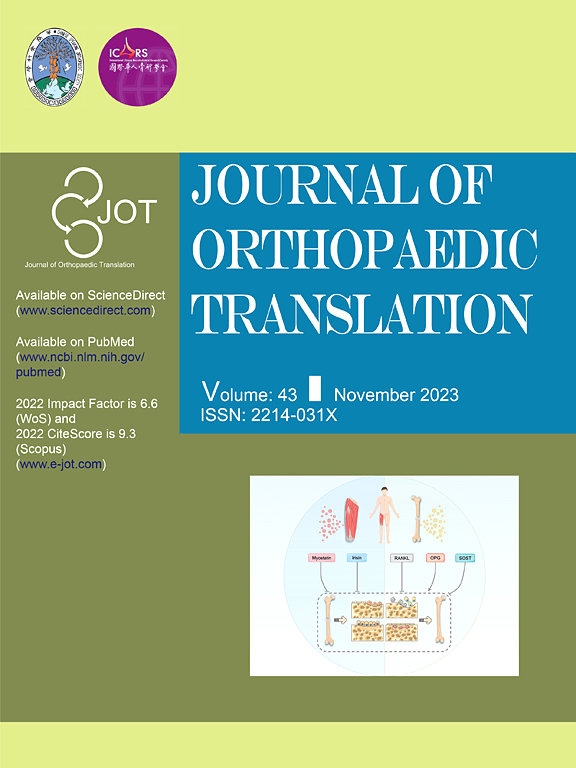PTHrP buffers Wnt/β-catenin activity through a PKC-ζ involved negative feedback loop to maintain articular cartilage homeostasis and attenuate osteoarthritis
IF 5.9
1区 医学
Q1 ORTHOPEDICS
引用次数: 0
Abstract
Background
Osteoarthritis (OA) is the most common joint disease worldwide and a leading cause of disability. The Wnt/β-catenin cascade is essential in articular cartilage development and homeostasis. Interruption of β-catenin (either overexpression or inhibition) leads to cartilage degeneration. However, the mechanism for stabilizing Wnt/β-catenin remains unclear.
Methods
We established the mouse destabilization of the medial meniscus (DMM) OA model and analyzed the clinical specimens to detect Wnt/β-catenin and PTHrP. The chondrocytes were isolated and treated with various cytokines including Wnt3a, Ihh, IL-1β, and PTHrP to reveal the molecular mechanism. Epigenetic and bioinformatic analyses were conducted to screen the key genes for the PTHrP regulation, and an Adeno-associated Virus (AAV) delivery system for PTHrP was established for OA gene therapy (prevention) application.
Results
We confirmed the Wnt/β-catenin activation and PTHrP suppression in cartilage in post-traumatic OA. Wnt/β-catenin further upregulated PTHrP expression through binding to its promoter (P2), and induced mRNA (AT6) transcript expression. Unexpectedly, PTHrP repressed Wnt/β-catenin activity and formed a Wnt/β-catenin-PTHrP negative feedback loop in very primary chondrocytes to maintain cartilage homeostasis. However, this negative feedback loop vanished in dedifferentiated chondrocytes, hypertrophic chondrocytes, and IL-1β treated primary chondrocytes. In these chondrocytes under pathological conditions, we further found that miR-106b-5p was increased and directly targeted PTHrP mRNA to abolish the feedback loop. Using Bulk RNA-seq and KEGG analysis, we screened and confirmed that PKC-ζ was activated by PTHrP through phosphorylation at Thr410/403, and subsequently induced β-catenin phosphorylation, ubiquitination and degeneration. Finally, we disclosed that exogenous PTHrP attenuated OA progression.
Conclusion
This study reveals that PTHrP is a vital mediator in keeping Wnt/β-catenin homeostasis through a negative feedback loop similar to its role in balancing the Ihh pathway activity in the secondary ossification center and growth plate.
The translational potential of this article
These findings highlight that PTHrP might be a therapeutic target for attenuating cartilage degeneration and OA process by the gene therapy approach.

PTHrP通过PKC-ζ参与的负反馈回路缓冲Wnt/β-catenin活性,以维持关节软骨稳态和减轻骨关节炎
骨关节炎(OA)是世界上最常见的关节疾病,也是导致残疾的主要原因。Wnt/β-连环蛋白级联在关节软骨发育和体内平衡中是必不可少的。β-catenin的中断(过度表达或抑制)导致软骨变性。然而,稳定Wnt/β-catenin的机制尚不清楚。方法建立小鼠内侧半月板失稳(DMM) OA模型,对临床标本进行Wnt/β-catenin和PTHrP检测。分离软骨细胞,用Wnt3a、Ihh、IL-1β、PTHrP等多种细胞因子处理,揭示其分子机制。通过表观遗传学和生物信息学分析筛选PTHrP调控的关键基因,建立PTHrP腺相关病毒(AAV)传递系统,用于OA基因治疗(预防)应用。结果证实外伤性骨性关节炎软骨中Wnt/β-catenin的激活和PTHrP的抑制。Wnt/β-catenin通过结合PTHrP启动子(P2)进一步上调PTHrP表达,诱导mRNA (AT6)转录物表达。出乎意料的是,PTHrP抑制Wnt/β-catenin活性,并在非常初级的软骨细胞中形成Wnt/β-catenin-PTHrP负反馈回路,以维持软骨稳态。然而,这种负反馈回路在去分化软骨细胞、肥大软骨细胞和IL-1β处理的原代软骨细胞中消失。在这些病理状态下的软骨细胞中,我们进一步发现miR-106b-5p升高,并直接靶向PTHrP mRNA,消除反馈回路。通过Bulk RNA-seq和KEGG分析,我们筛选并证实PKC-ζ被PTHrP通过Thr410/403磷酸化激活,随后诱导β-catenin磷酸化、泛素化和变性。最后,我们发现外源性PTHrP可以减缓OA的进展。结论PTHrP是维持Wnt/β-catenin稳态的重要介质,其作用类似于平衡继发性骨化中心和生长板中Ihh通路活性的负反馈循环。这些发现强调PTHrP可能是通过基因治疗方法减轻软骨退变和OA过程的治疗靶点。
本文章由计算机程序翻译,如有差异,请以英文原文为准。
求助全文
约1分钟内获得全文
求助全文
来源期刊

Journal of Orthopaedic Translation
Medicine-Orthopedics and Sports Medicine
CiteScore
11.80
自引率
13.60%
发文量
91
审稿时长
29 days
期刊介绍:
The Journal of Orthopaedic Translation (JOT) is the official peer-reviewed, open access journal of the Chinese Speaking Orthopaedic Society (CSOS) and the International Chinese Musculoskeletal Research Society (ICMRS). It is published quarterly, in January, April, July and October, by Elsevier.
 求助内容:
求助内容: 应助结果提醒方式:
应助结果提醒方式:


